Saffron, often referred to as the "king of spices," is a prised ingredient that has been cherished for centuries due to its vibrant colour, distinctive flavour, and potential health benefits. However, its popularity has led to the proliferation of counterfeit and low-quality saffron in the market. Learning to distinguish genuine saffron from imitations, fake saffron is essential to ensure you're getting the authentic and valuable product. In this blog post, we'll delve into the characteristics and techniques that can help you identify genuine saffron.
Examine the Threads:
Genuine saffron consists of stigma and style threads, which are thin and delicate. These threads are usually about 2.5 cm to 4 cm in length and feature a deep crimson colour with a slightly lighter red or orange tip. The threads should be uniform in size and length, reflecting the meticulous hand-harvesting process that saffron requires.
Check for Aroma:
Aroma is a telltale sign of authentic saffron. Real saffron emits a strong, distinct aroma that is often described as floral, slightly sweet, and somewhat metallic. If the saffron threads lack this aroma or have a musty smell, it's likely a sign of lower quality or imitation saffron.
Observe Colour Release:
When genuine saffron is steeped in warm water or milk, it gradually imparts a rich, golden colour. The water should turn a deep yellow or orange hue, and the saffron threads themselves should retain their vibrant colour even after being soaked. Imitation saffron might release colour quickly and unevenly, resulting in a pale and weak tint.
Feel the Texture:
Genuine saffron threads have a dry and brittle texture, which makes them crumble easily between your fingers. If the threads feel oily or sticky, it could be an indication that they've been adulterated with oil or other substances to increase their weight.
Water Test:
Perform a simple water test to identify pure saffron. Place a few threads of saffron in a small bowl of water. Genuine saffron threads will slowly release colour, and they should not leave behind any residue or colorant in the water.
Price and Source:
While price can vary depending on factors like region and quality, extremely low-priced saffron should raise suspicions. High-quality saffron is labour-intensive to produce, which contributes to its cost. Purchase saffron from reputable sources, such as trusted spice shops or well-known brands such as Luxurients, to minimise the risk of purchasing counterfeit saffron.
Packaging and Labels:
Legitimate saffron is often packaged in small quantities due to its potency. Look for clear labelling that includes the saffron's origin, grade, and any certifications it might have. Packaging that doesn't provide transparent information should be approached with caution.
Conclusion:
As the demand for saffron continues to grow, so does the prevalence of fake and low-quality products in the market. Armed with the knowledge of these key identification techniques, you can confidently select and purchase genuine saffron for your culinary endeavours. Whether you're using it to add a touch of luxury to your dishes or exploring its potential health benefits, authentic saffron's unique flavour and colour will undoubtedly elevate your experiences in the kitchen.
Luxurients is the brand based in the UK and serve customers round the world. Luxurients is a certified Saffron brand and has been awarded with highest rating during Great Taste annual awards in year 2022 in the London, UK. Luxurients only work with certified and registered grovers hence why the saffron is of very high quality.


